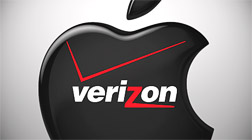Rumors about a Verizon iPhone have swirled ever since the original’s introduction in 2007. Although many say the earliest Apple could go to Verizon is when LTE becomes available, that’s not necessarily the case.
As more and more evidence of a Verizon-compatible CDMA iPhone appears, there are those who still claim Apple will never produce a device based on the technology. It’s remained popular belief that, aside from Apple’s exclusive agreement with AT&T, the wait for next-generation LTE networking is what’s holding up a Verizon iPhone. This is an unrealistic view and almost certainly not the reason the iPhone is still tied to AT&T.
What is CDMA and LTE?
First, an overview about the technology behind mobile phones and networks. The iPhone is a GSM/UMTS-based device, which are the protocols used by AT&T and T-Mobile in the U.S., as well as most international cell carriers. Apple’s use of GSM/UMTS chips in their phones means they can build one iPhone that works around the world. Verizon and Sprint, on the other hand, use CDMA for their networks. It’s an outdated technology that is incompatible with GSM/UMTS and slowly being phased out. As a result, Verizon will be adopting LTE for their 4th generation network – the next standard in the GSM/UMTS line of technologies. This means AT&T and Verizon will more or less have compatible networks when LTE hits. Sounds like the perfect time for a Verizon iPhone, right? If only it were that simple.
Timelines and technicalities
If certain people are to be believed, Apple can bypass CDMA by waiting for Verizon to launch their 4G LTE network in late 2010 or early 2011. What they seem to be forgetting is that network rollouts don’t happen with the flip of a switch. While CDMA is certainly on its way out, it will still be around for a number of years. Verizon says, assuming everything goes as planned, it won’t have nationwide LTE coverage completed until 2013. That makes 2013 the earliest Apple could sell a Verizon iPhone with just LTE and no CDMA. Why? A minimal number of markets will have 4G coverage at first, so CDMA will still be the only type of network available to many Verizon customers.
Even though AT&T has a widespread 3G network, there are many areas that are still only covered by the 2G EDGE network. The same goes for Sprint’s new 4G network, which is already up & running in some big markets, yet nonexistent in most others. This is very much how Verizon will look for a few years as it rolls out 4G LTE – large areas still reliant on CDMA. Can you imagine Apple selling an iPhone that only supports 3G on AT&T and can’t connect to 2G EDGE? It just wouldn’t happen. And that’s exactly what selling an LTE only phone for Verizon before 2013 would be like. Any Verizon phone sold for at least the next 3-5 years will still need to support CDMA, including an iPhone.
Conclusions
I have no inside information about Apple’s iPhone negotiations with either AT&T or Verizon. A Verizon iPhone could come early next year or never at all. But if Apple is planning on expanding to Verizon before at least 2013, they simply can’t skip CDMA just because it is a dying technology, as many people claim they can. For the sake of backwards compatibility and offering coverage to all Verizon customers, CDMA and LTE are both required. And if that’s the case, why wait for LTE to introduce a Verizon iPhone? Apple can and should get started with CDMA whenever they want, assuming exclusivity with AT&T has ended or been cut off earlier than expected.









